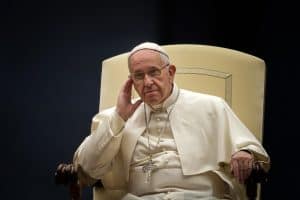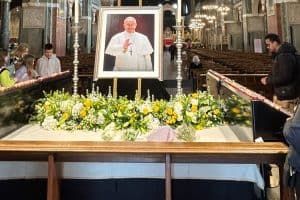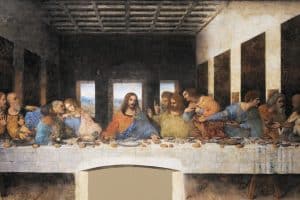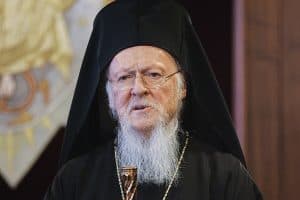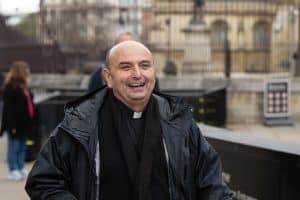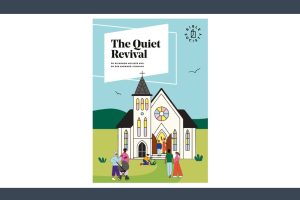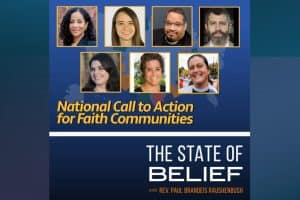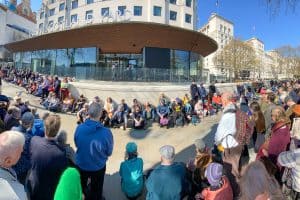By Ruth Peacock
A Church of England vicar with 176,000 Instagram followers, a young imam whose following increased tenfold in the pandemic, and church worship attracting four times as many people online as in person. The internet appears to have witnessed an explosion in religious quest and observance during the pandemic.
The Rev Chris Lee, an Anglican vicar from west London, told a Religion Media Centre online briefing that many young people in particular connect with his 60-second sermons offering a non-judgmental take on events and life; bringing hope, life and light into the diet of “me myself and I” on social media.
People of no faith, a variety of Christian traditions and other faiths, from all over the world, now follow him, so that he has more followers than the Church of England online. “It’s been a wild ride of communicating this message of hope on a platform often seen as superficial,” he said.
He explained that living through a pandemic felt like a war, where people felt vulnerable, experienced suffering and were forced to be distant from one another. People were searching and looking online for something divine, Mr Lee said.
They were finding friendship, and swapping experiences, even through alter egos such as avatars, through gaming. But they were real people forming real communities in new forms. His Instagram following is larger than the Church of England’s.
Through Instagram, Mr Lee met Sabah Ahmedi, “the Young Imam”, whose following rocketed during the pandemic. He shared the experience of finding that young people are looking for hope, friendship and to build community: “I’m trying to create a platform for conversation and dialogue and to allow people to ask questions about Islam and faith.”
He tackles current affairs and issues such as alcohol and drug abuse, or gaming addictions with harmful effects on mental health, offering instead a “balanced approach” to life and faith, which can bring positivity and happiness.
Salim Kassam, co-founder and editor-in-chief of The Muslim Vibe, said they had identified a gap where young people were engaging and scrolling through social media to find “there’s a lot of very fickle, materialistic, throwaway content”, but he wanted to offer something motivational and inspirational, so their website was set up to attract an audience aged 18-35, mainly western Muslims. Numbers using the site showed there was a huge need and uptake.
The spike in demand and resurgence of interest in matters spiritual during this health crisis is no surprise to the Rev Dr Peter Phillips, director of the Codec Research Centre for Digital Theology, at Durham University. His research with Savanta Comres suggested up to 28 per cent of the population engaged with online worship in the pandemic, including an even higher number (48 per cent) of young people. He said church congregations usually attract four million each Sunday, but the figures show this had the potential to engage 15.6 million online.
Going forward, it must be possible, he said, to have both physical and digital services in a form of hybrid worship. Online worship had been going for decades, but the church as a whole had been catching up in the past year.
The surge in online activities included people of real flesh and blood, he said, but this had repercussions for the way holy communion was understood. As a Methodist, “I’m fervently of the belief that God can consecrate bread and wine across the internet and that we should be having online communion”, Dr Phillips said. But the Methodist church disagreed on theological grounds.
The Rev Miranda Threlfall-Holmes, a blogger and vicar of St Luke in the City, Liverpool, agreed, saying that communion was not some kind of magic, but about a community gathering round to remember the story of Jesus.
She was annoyed at the distinction between real worship and online worship. “What we do online is sacramental,” she said. People have been saved from depression, isolation and even converted online, which is a sign of “God’s grace”, she said.
The debate over whether or how communion may be celebrated online has become one of the key areas of theological disagreement during the pandemic. In the sacrament of the communion, the priest blesses the bread and wine as a symbol of the body and blood of Jesus Christ.
Dom Christopher Jamison said the classic Catholic theology of the “real presence of the body of Christ, requires real bodies”, so online communion seriously challenged this. And the Rev Chris Lee said observing communion in a recorded service was another difficult leap. Theological books were being written and churches were giving prescriptive advice while ideas develop.
Christopher Jamison wondered what place would remain for physical places of worship, now that people were used to attending online.
Salim Kassam explained that in Islam, there was an emphasis on community prayer and being in a mosque was a key social element in community life. Sabah Ahmedi added that praying together gave an energy and encouraged good mental health, as friendship and belonging was encouraged.
Mr Lee said church buildings would not be replaced, but as church became more accessible online, church structures might have to change.
Dr Phillips predicted that physical worship would continue in buildings and be the norm, but the actual working out of faith — the discussion groups, prayer meetings, Bible studies and social gatherings — might move onto Zoom. He said faith should influence every single part of life and not be restricted to public worship.
This was the last RMC zoom briefing on the impact of Covid-19 on religion in the UK. All the films are on our YouTube channel here


